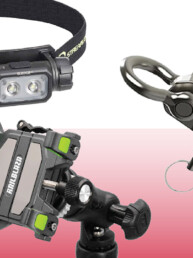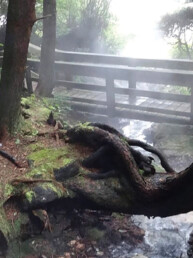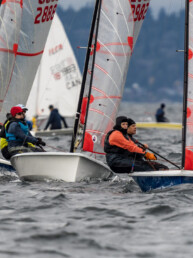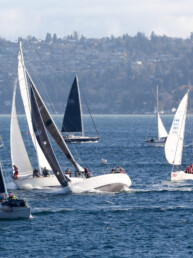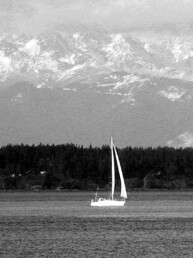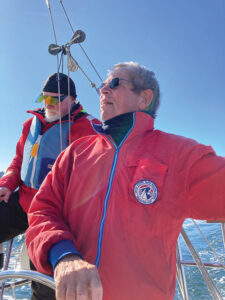
Before I moved to the Pacific Northwest and took up sailing, my use of the expression “changing tack” often meant adjusting my mathematics lesson plan if it floundered in front of my high school students. Now, having a few sailing seasons under my belt, I reference the phrase literally, along with an array of other nautical terms I have learned to employ during an afternoon on the water.
My application of the lexicon has come slowly, with my wife, Laura supporting my knowledge and skill acquisition when the two of us venture out on the waters of the Salish Sea. As in my teaching career and my woodworking hobby, I often learn best by doing. In those pursuits, however, I’m generally left to my own devices since these tend to be solitary endeavors. Thankfully, though, there are ample opportunities for help in the sailing world. As my comfort with the language, skills, and community of sailing has grown, it’s now easier to have an experienced sailor come on board and demonstrate a technique; more than it ever was to get a veteran teacher to observe one of my lessons and offer guidance.
That being said, I still find myself learning primarily in isolation, trying to track my own personal growth and knowledge now that my “classroom” consists of our Columbia 28, Ariel.
During my current maritime education, I’m reminded of the four stages of progress in learning a new behavior or skill, whether the setting is a school or the waters of Puget Sound:
- Unconscious incompetence, or not knowing what you don’t know;
- Conscious incompetence, or the realization of knowing that you’re doing something wrong, but an inability to rectify it;
- Conscious competence, or being aware and focused in order to perform a job correctly;
- Unconscious competence, or achievement without the thought or need to concentrate on success or optimum performance.
I have yet to attain stage four in the learning process for any task on Ariel. I’m more often in stage one, having had little training or instruction in actually sailing a vessel, learning mostly through trial, error, and research; too often unaware of the mistakes that I might be making.
Considering all of this, it must sound far-fetched to hear that the moment I stepped aboard the old sloop, my goal was to make her go as fast as possible; to squeeze every pound of force from the wind and the tide; to set the sails in perfect harmony with heading, keel, and rudder. It was perhaps a fool’s errand, and foolishness and inexperience often go hand-in-hand. Additionally, my efforts frequently lead to an uncomfortable ride for Laura and frustrations for me.
In the two years that have followed our purchase of Ariel, I have realized that I should be learning to sail better, not faster. But in order to achieve that goal, I have to wonder, what does it mean to sail better? Does better mean faster? Or more efficiently? More comfortably? Or maybe even to experience more excitement and thrill? The answer depends on who’s asking.
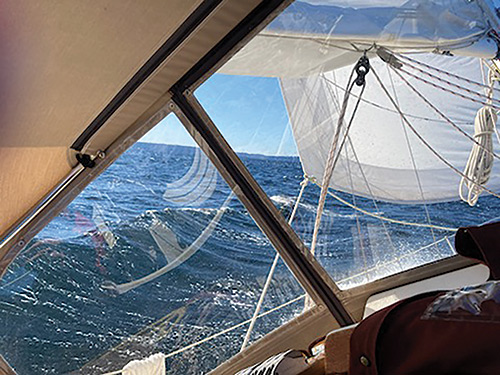
For Laura, the best part of sailing is simply being on the water, though even that feeling could be improved were she to actually be in the water, cold temperatures notwithstanding. For a racer, the answer deals with speed, efficiency, and control (winning doesn’t hurt either). For cruisers, perhaps, comfort and amenities top the list, along with a worthwhile destination. In truth, each sailor’s priorities are almost always unique, complex, and elusive.
You might as well ask, what does it mean to walk better? You could talk about technique and efficiency or purpose and intention, but you can’t ignore what walking does for your mood, energy level, and maybe even your soul. The same could be said of sailing. I don’t actually ask that question about walking, maybe because I’ve been doing it for about 60 years now. I feel fairly certain that I’m in stage four regarding my level of perambulatory skill.
But sailing is not only a new activity for me, it’s one that I only occasionally partake in, unlike walking. So getting better at it is a slow process, and one in which the conditions are constantly variable. Taking Ariel out on a calm, bright summer day is not the same as braving a strong, chilly wind in January. We’ve yet to round Point Defiance with the same tide and wind conditions, and we have learned to check tidal predictions and wind forecasts every time we head towards the Narrows. Each setting requires not only a different set of skills and preparation, but a unique outlook on the purpose and intention of the day. Our outings may be defined by barely full sails, music drifting across glassy waters, cold beer, and warm sunscreen; while others demand a reefed main, hot coffee, and heavy foul weather gear.
Somewhere between the two extremes lies the majority of our sailing experiences, giving me ample learning opportunities. When trying to move along the continuum toward “conscious competence” in these situations, the best advice that I offer anyone (or take to heart myself) is to seek out knowledge and advice from more experienced sailors, and pay close attention to their methods and techniques when possible. As the baseball legend Yogi Berra quipped, “You can observe a lot by just watching,” which is exactly what I did on a recent sailing venture.
On a cold, blustery, and crystal-clear afternoon, my dockmate, Tom, invited me and a fellow club member, Fred, for an afternoon sail on one of our boats. After a Rochambeau challenge to decide whose vessel we would take, the three of us ended up on Barquinho, Tom’s Cal 30, with the hopes of setting up an informal weekly ride-along on each other’s boats in the months to come. We set out with 15 knot winds tautly displaying our club’s American flag at the mouth of the marina, prompting both Fred and Tom’s suggestion to reef immediately.
Tom directed the process from the foredeck, handling the main halyard while Fred was at the wheel. After the main was hoisted to about 75% of her fully extended size, I tightened the reef line from the cockpit. We then unfurled the jib to about 80%, and headed to windward as Barquinho heeled in response, cutting through the whitecaps and shedding the splash and spray that leapt across her bow.
We headed towards Brown’s Point close-hauled, hoping to round the point without changing course. The two experienced sailors and I were excited to sail as fast as the wind and waves could carry us. For the three of us, sailing with the rail nearly in the water was exhilarating and just plain fun.
Since the knotmeter’s paddle wheel was jammed, we could only guess our speed until I opened my Navionics app to confirm our estimates. I excitedly called out the varying readings: 5.4, 5.7, 6.2, 5.8.
We proceeded to make minor adjustments to the sheets and traveler, even experimenting with the location of the jib car along its track while Fred headed up into the wind to create a minor luff of the foresail.
Unable to fetch the point on our initial heading, we decided to tack towards Vashon Island with the wind still driving hard. As our afternoon closed out and we fell off for our return leg back to the marina, our beam reach nearly righted Barquinho, and, not surprisingly, increased her speed as well. While taking my turn at the helm, I carefully opened my phone app again, confidently claiming our slightly improved speed: 6.1, 5.9, 6.3!
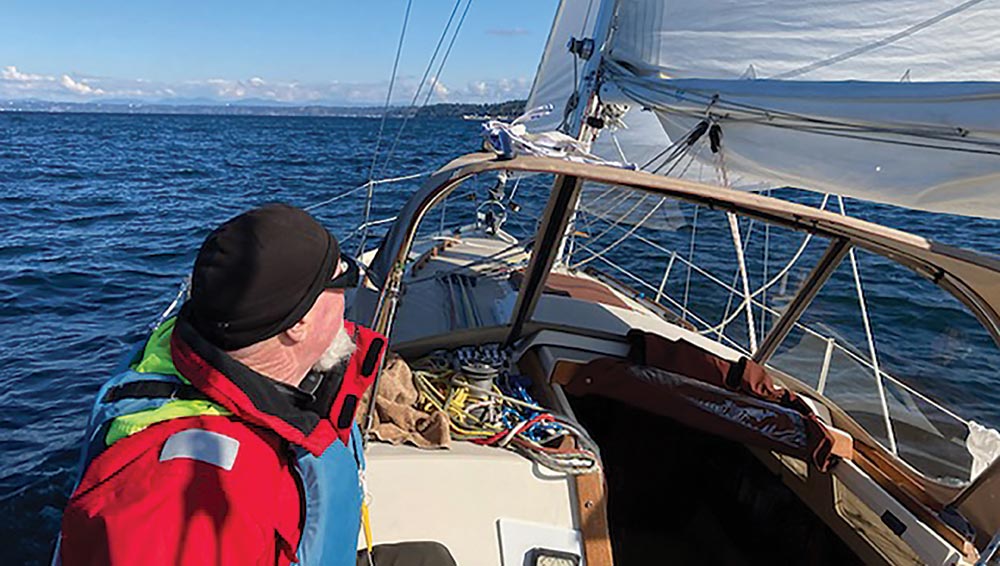
The values, while improved, couldn’t hide the slight disappointment of the crew. With the reduced apparent wind speed after our course change, Barquinho’s ride was less compelling and exciting, prompting me to ponder the idea that if it doesn’t feel like you’re moving fast, then are you? And more to the point, which situation offered us better sailing?
Sailing close-hauled in fresh breeze required focus, preparation, and response, both mentally and physically, as movement in the cockpit and on deck was precarious and difficult. How we trimmed the sails felt much like a dance between wind direction and heading. Despite those challenges, or perhaps because of them, we found ourselves in a state of flow.
The balance point that occurs in the delicate zone between boredom and anxiety was explored by the late Hungarian psychologist Mihaly Csikszentmihalyi, and has been studied by presidents, coaches, and business executives alike. As Csikszentmihalyi wrote in 1990, “The best moments in our lives are not the passive, receptive, relaxing times… The best moments usually occur if a person’s body or mind is stretched to its limits in a voluntary effort to accomplish something difficult and worthwhile.” The afternoon sail perfectly fit the conditions that the psychologist described.
As we headed back to the marina, Tom and Fred furled the jib and dropped the main while I was at the helm. Tom took over the wheel as we approached the slip while Fred and I readied the fenders and dock lines. We all agreed that we couldn’t have asked for a better sail. The afternoon allowed Tom and Fred to tame the wind and master the features and design of the Cal 30, trimming it to do what she does best.
For me, it was less about knowledge of the boat in particular, and more about trying to absorb knowledge from my fellow sailors. Seeing their joy, I realized that there really is only one answer to what it means to sail better. Regardless of the objective or the intention, the time of year, or even the level of skill or ability, better sailing means existing in that perfect-for-you balance where the challenge of the experience lies just at the edge of our skill level. Whether we are racers, cruisers, or day sailors, we find joy and satisfaction when our minds and bodies are fully engaged.
David Casey is a retired math teacher and semi-professional woodworker and bass player. He plans on using his retirement to build a small sailboat and a kayak, and to explore the waters of southern Puget Sound.

